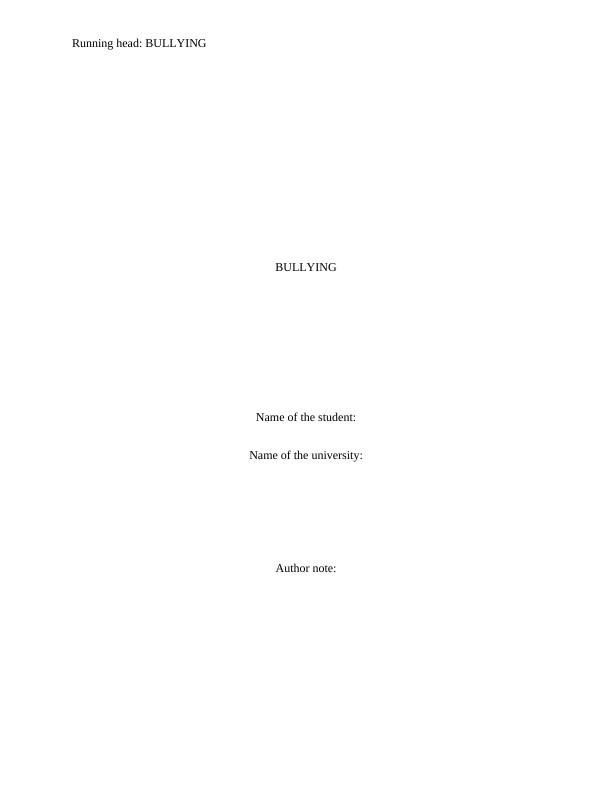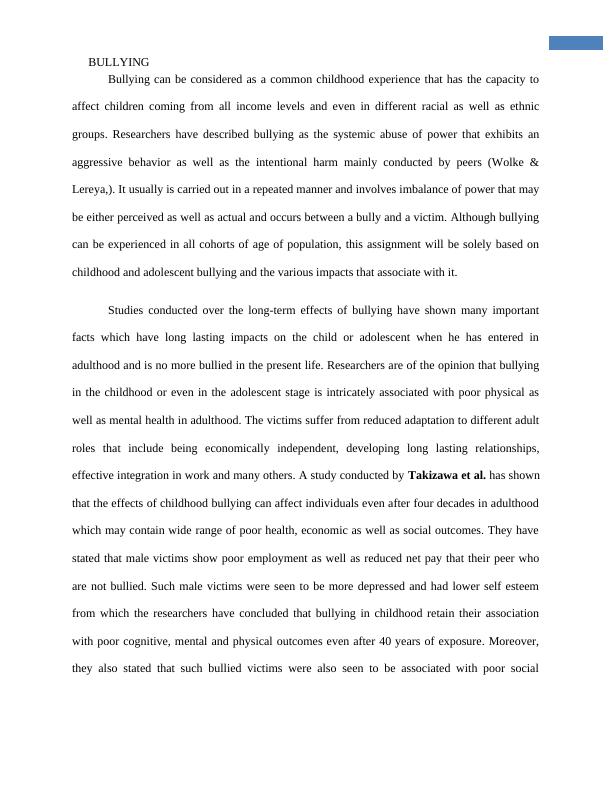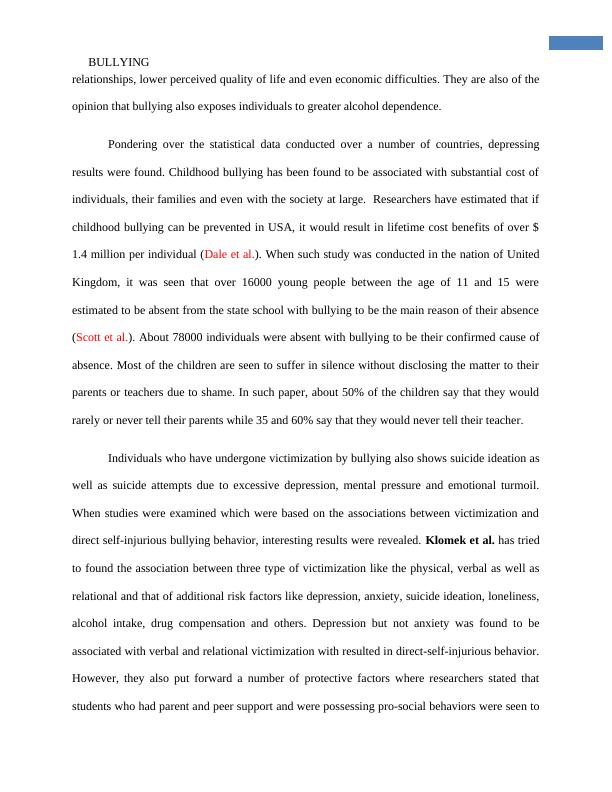Long-term Effects of Childhood and Adolescent Bullying
Added on 2023-06-13
7 Pages1449 Words232 Views
Running head: BULLYING
BULLYING
Name of the student:
Name of the university:
Author note:
BULLYING
Name of the student:
Name of the university:
Author note:

1
BULLYING
Bullying can be considered as a common childhood experience that has the capacity to
affect children coming from all income levels and even in different racial as well as ethnic
groups. Researchers have described bullying as the systemic abuse of power that exhibits an
aggressive behavior as well as the intentional harm mainly conducted by peers (Wolke &
Lereya,). It usually is carried out in a repeated manner and involves imbalance of power that may
be either perceived as well as actual and occurs between a bully and a victim. Although bullying
can be experienced in all cohorts of age of population, this assignment will be solely based on
childhood and adolescent bullying and the various impacts that associate with it.
Studies conducted over the long-term effects of bullying have shown many important
facts which have long lasting impacts on the child or adolescent when he has entered in
adulthood and is no more bullied in the present life. Researchers are of the opinion that bullying
in the childhood or even in the adolescent stage is intricately associated with poor physical as
well as mental health in adulthood. The victims suffer from reduced adaptation to different adult
roles that include being economically independent, developing long lasting relationships,
effective integration in work and many others. A study conducted by Takizawa et al. has shown
that the effects of childhood bullying can affect individuals even after four decades in adulthood
which may contain wide range of poor health, economic as well as social outcomes. They have
stated that male victims show poor employment as well as reduced net pay that their peer who
are not bullied. Such male victims were seen to be more depressed and had lower self esteem
from which the researchers have concluded that bullying in childhood retain their association
with poor cognitive, mental and physical outcomes even after 40 years of exposure. Moreover,
they also stated that such bullied victims were also seen to be associated with poor social
BULLYING
Bullying can be considered as a common childhood experience that has the capacity to
affect children coming from all income levels and even in different racial as well as ethnic
groups. Researchers have described bullying as the systemic abuse of power that exhibits an
aggressive behavior as well as the intentional harm mainly conducted by peers (Wolke &
Lereya,). It usually is carried out in a repeated manner and involves imbalance of power that may
be either perceived as well as actual and occurs between a bully and a victim. Although bullying
can be experienced in all cohorts of age of population, this assignment will be solely based on
childhood and adolescent bullying and the various impacts that associate with it.
Studies conducted over the long-term effects of bullying have shown many important
facts which have long lasting impacts on the child or adolescent when he has entered in
adulthood and is no more bullied in the present life. Researchers are of the opinion that bullying
in the childhood or even in the adolescent stage is intricately associated with poor physical as
well as mental health in adulthood. The victims suffer from reduced adaptation to different adult
roles that include being economically independent, developing long lasting relationships,
effective integration in work and many others. A study conducted by Takizawa et al. has shown
that the effects of childhood bullying can affect individuals even after four decades in adulthood
which may contain wide range of poor health, economic as well as social outcomes. They have
stated that male victims show poor employment as well as reduced net pay that their peer who
are not bullied. Such male victims were seen to be more depressed and had lower self esteem
from which the researchers have concluded that bullying in childhood retain their association
with poor cognitive, mental and physical outcomes even after 40 years of exposure. Moreover,
they also stated that such bullied victims were also seen to be associated with poor social

2
BULLYING
relationships, lower perceived quality of life and even economic difficulties. They are also of the
opinion that bullying also exposes individuals to greater alcohol dependence.
Pondering over the statistical data conducted over a number of countries, depressing
results were found. Childhood bullying has been found to be associated with substantial cost of
individuals, their families and even with the society at large. Researchers have estimated that if
childhood bullying can be prevented in USA, it would result in lifetime cost benefits of over $
1.4 million per individual (Dale et al.). When such study was conducted in the nation of United
Kingdom, it was seen that over 16000 young people between the age of 11 and 15 were
estimated to be absent from the state school with bullying to be the main reason of their absence
(Scott et al.). About 78000 individuals were absent with bullying to be their confirmed cause of
absence. Most of the children are seen to suffer in silence without disclosing the matter to their
parents or teachers due to shame. In such paper, about 50% of the children say that they would
rarely or never tell their parents while 35 and 60% say that they would never tell their teacher.
Individuals who have undergone victimization by bullying also shows suicide ideation as
well as suicide attempts due to excessive depression, mental pressure and emotional turmoil.
When studies were examined which were based on the associations between victimization and
direct self-injurious bullying behavior, interesting results were revealed. Klomek et al. has tried
to found the association between three type of victimization like the physical, verbal as well as
relational and that of additional risk factors like depression, anxiety, suicide ideation, loneliness,
alcohol intake, drug compensation and others. Depression but not anxiety was found to be
associated with verbal and relational victimization with resulted in direct-self-injurious behavior.
However, they also put forward a number of protective factors where researchers stated that
students who had parent and peer support and were possessing pro-social behaviors were seen to
BULLYING
relationships, lower perceived quality of life and even economic difficulties. They are also of the
opinion that bullying also exposes individuals to greater alcohol dependence.
Pondering over the statistical data conducted over a number of countries, depressing
results were found. Childhood bullying has been found to be associated with substantial cost of
individuals, their families and even with the society at large. Researchers have estimated that if
childhood bullying can be prevented in USA, it would result in lifetime cost benefits of over $
1.4 million per individual (Dale et al.). When such study was conducted in the nation of United
Kingdom, it was seen that over 16000 young people between the age of 11 and 15 were
estimated to be absent from the state school with bullying to be the main reason of their absence
(Scott et al.). About 78000 individuals were absent with bullying to be their confirmed cause of
absence. Most of the children are seen to suffer in silence without disclosing the matter to their
parents or teachers due to shame. In such paper, about 50% of the children say that they would
rarely or never tell their parents while 35 and 60% say that they would never tell their teacher.
Individuals who have undergone victimization by bullying also shows suicide ideation as
well as suicide attempts due to excessive depression, mental pressure and emotional turmoil.
When studies were examined which were based on the associations between victimization and
direct self-injurious bullying behavior, interesting results were revealed. Klomek et al. has tried
to found the association between three type of victimization like the physical, verbal as well as
relational and that of additional risk factors like depression, anxiety, suicide ideation, loneliness,
alcohol intake, drug compensation and others. Depression but not anxiety was found to be
associated with verbal and relational victimization with resulted in direct-self-injurious behavior.
However, they also put forward a number of protective factors where researchers stated that
students who had parent and peer support and were possessing pro-social behaviors were seen to

End of preview
Want to access all the pages? Upload your documents or become a member.
Related Documents
Assignment on Childhood Obesity in Queenslandlg...
|1
|2109
|20
RESEARCH PROPOSAL ON TRAUMA IN ADOLESCENCElg...
|10
|2426
|22
Assignment Prevalence of Bullying among Young Adults at Collegelg...
|13
|2995
|13
The Effect of Childhood Traumalg...
|5
|1206
|20
Factors of Depression: Education, Low Income, and Gender Inequalitylg...
|12
|3588
|452
Negative Impact of Social Media on Liveslg...
|7
|1661
|491
